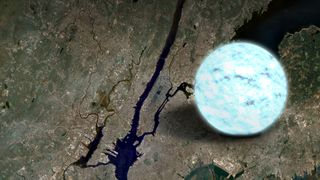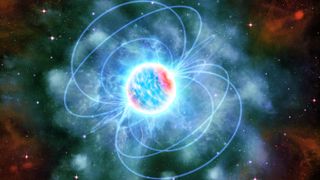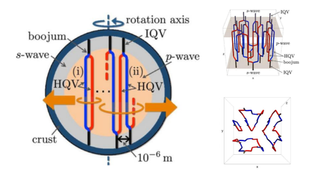Scientists may have unlocked the secret behind the still-beating hearts of the universe’s most extreme “dead stars,” and the explanation is twisted.
The team believes that an avalanche of quantum tornadoes causes this “glitch” in the rotation of a class of neutron stars called pulsars as they intertwine with their neighbors like the arms of a series of nearby cacti, creating twisted, intricate patterns.
“More than half a century has passed since the discovery of neutron stars, but the mechanism behind the disturbances is still not understood,” team member Muneto Nitta, a professor at Hiroshima University, said in a statement. “So we proposed a model to explain this phenomenon.”
Related: Scientists Discover Slowest-Spinning Radioactive Neutron Star, Breaking All Dead Star Rules
A team of researchers studied 533 pulsar observations to solve the mystery of these anomalies. They propose that these anomalies are the result of a “quantum vortex network” that aligns with power-law calculations, developing a model that requires no “extra tuning,” unlike previous models of neutron star anomalies.
Neutron Star ‘Problems’ Run Deep
Neutron stars are born when massive stars die, run out of fuel for nuclear fusion, and collapse under their own gravity. Their outer layers are blown away by massive supernova explosions. The result is a stellar core one to two times the mass of the Sun, which is crushed to a diameter of about 20 kilometers. That’s small enough to fit into an average city on Earth.
The result of this collapse is that electrons and protons are crushed together, creating a sea of neutrons so dense that if a tablespoon of it were brought back to Earth, it would weigh more than a billion tons, or more than Mount Everest.
The crushing of stellar cores is also responsible for the rapid rotation of young neutron stars, some reaching speeds of up to 700 rotations per second. This is due to the conservation of angular momentum, which is comparable to that of an ice skater on Earth who tucks in his arms to increase the speed of his rotation.
Newly “dead” neutron stars, or “pulsars,” appear to be pulsating because they spin rapidly and emit beams of radiation from their poles. Pulsars periodically brighten when their beams are aimed directly at Earth, giving them the appearance of being pulsated (hence their name). These pulsations can be compared to a cosmic “heartbeat” that is so precise that these young neutron stars can be used as cosmic timers in so-called pulsar timing networks to measure the time of celestial events.
There is a catch, however. Some neutron stars sometimes appear to experience “glitches,” briefly speeding up their rotation and delivery of impulses, disrupting the regularity of their heartbeat. The cause of these glitches remains shrouded in mystery.
Pulsar disturbances appear to follow a similar pattern, or “power law,” to that of earthquakes on Earth. Just as small earthquakes are more common than large ones, low-energy disturbances occur more often for pulsars than high-energy and extreme disturbances.

There are two predominant mechanisms involved in neutron star disruptions: starquakes and tiny “avalanches” of quantum vortices that form like microscopic hurricanes in the superfluid soup that makes up the interior of a neutron star.
Quantum vortices are generally more widely accepted as an explanation than starquakes because, while starquakes follow a power law like earthquakes, they struggle to explain all types of neutron star disturbances. Yet despite being more widely accepted, there is no real explanation for what would trigger a catastrophic avalanche of superfluid vortices that could reach the surface of a neutron star and cause it to spin faster.
“In the standard scenario, the researchers consider that the avalanche of unfixed vortices could explain the origin of the problems,” Nitta explains in the press release. “If there were no blockage, it would mean that the superfluid releases the vortices one by one, which would allow a smooth adjustment of the rotation speed. There would be no avalanches and no problems.”
Nitta added that the team’s model doesn’t need an additional anchoring mechanism. It simply needs to account for a structure composed of two types of waves propagating in the superfluid interior of a neutron star: a “P-wave,” which is a fast-moving longitudinal wave, and an “S-wave,” which is a slower-moving transverse wave.
“In this structure, all the vortices are connected to each other in each cluster, so they cannot be released one by one,” Nitta continues. “Instead, the neutron star must release a large number of vortices simultaneously. This is the key point of our model.”

Ordinary matter in neutron stars is a brake
The team’s model suggests that the superfluid core of a neutron star spins at a constant speed, but that the “ordinary” non-superfluid component slows it down. This results in the neutron star’s rotation rate being slowed by the emission of electromagnetic pulses and tiny ripples in space and time, called gravitational waves.
Over time, the velocity difference increases, causing the interior of the neutron star to expel superfluid vortices, carrying angular momentum, accelerating the ordinary component, and causing the increased rotation rates we observe as pulsar glitches.
The team suggests that the superfluid in neutron stars is divided into two types, which explains how these vortices are born. S-wave superfluids, which dominate the outer core of the neutron star, provide a relatively quiet environment that favors the formation of vortices with integer spins. However, in the inner core of a neutron star, the team thinks P-wave superfluidity dominates, creating extreme conditions that favor vortices with half-integer spins.
This means that a full spin vortex would split into two half-full vortices as it entered the p-wave dominated inner core. This creates a superfluid structure called a “boojum” that is shaped like a cactus. As more half-vortices are created and connected by boojums, the dynamics of the vortex groups become increasingly complex. Think of it like the arms of a cactus intertwining with those of a neighboring plant, creating increasingly intricate and twisted patterns.

The team ran simulations that showed their model comes very close to reproducing the energies of real-world neutron star pips.
“Our argument, although simple, is very powerful. Even though we cannot directly observe the p-wave superfluid inside, the logical consequence of its existence is the power-law behavior of the cluster sizes obtained from simulations,” said Shigehiro Yasui, a team member and associate professor at Nishogakusha University. “Translating this into a corresponding power-law distribution for the glitch energies showed that it matches the observations.”
“A neutron star is a very special situation, because the three fields of astrophysics, nuclear physics, and condensed matter physics meet at one point,” Yasui concludes. “It is very difficult to observe it directly, because neutron stars exist far away from us. So we need to establish a deep connection between the internal structure and some observational data of the neutron star.”
The team’s research is published in the journal Scientific Reports.